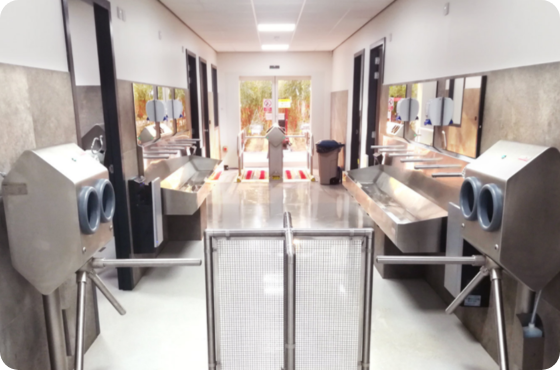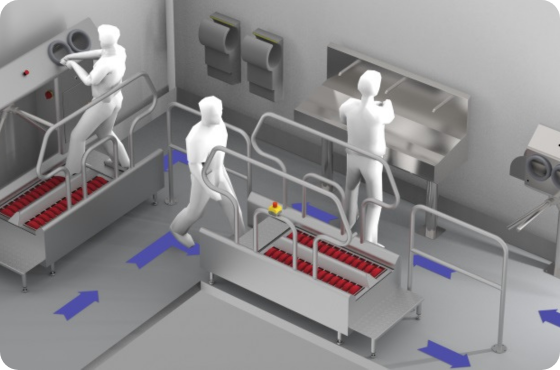Quality Products
Fast Delivery
Premium Service
Written by Dirk Timmers | Last update: 9. August 2023
It's common practice to have a hygiene station for hand disinfection at greenhouse entrances. Hand disinfection alone isn't enough to eliminate bacteria and safeguard against crop contamination. In this article, our experts discuss solutions for comprehensive greenhouse hygiene by listing best practices for entering a horticultural facility.

Cleaning and disinfecting are distinct, yet intertwined, parts of proper hygiene practice. Proper hand disinfection should following a thorough cleaning. Cleansing hands with soap eliminates the existing layer of dirt and grease. This step is vital, because it allows greenhouse disinfectant to work on stubborn bacteria on the hands. Without an intitial cleaning, the disinfectant wouldn't get through the barrier of dirt and grease.
With greenhouse hygiene, maintaing a two-fold approach is crucial: start with hand cleansing using soap to eliminate dirt and grease, and then apply a suitable greenhouse disinfectant to eliminate any residual bacteria. This ensures meticulous cleansing and disinfection, which minimizes the risk of contamination within the greenhouse.
In the dynamic landscape of today's horticultural realm, technological advancements and innovation have revolutionized practices for disinfection of greenhouse interiors. From automated spraying systems to sophisticated fogging techniques, adopting modern solutions are key to improving the efficiency and efficacy of disinfection procedures. Maintaining a clean, sanitized greenhouse interior is important for safeguarding plants against disease. Skipping these simple but crucial steps can cause a breeding ground for pathogens and pests, which can decrease crop quality, yield depreciation, and increase production expenditures. The act of disinfecting the greenhouse interior serves to disrupt the disease cycle.
In the video below, experts discuss the benefits of the hygiene station, and the useage of greenhouse disinfectant. You can get nsights into how to harness the full potential of the hygiene station to maintain optimal greenhouse hygiene standards.
The intrusion of bacteria or other plant pathogens into the crop can lead to major issues. To prevent this, it's important to establish a hygienic environment that stops the transmission of these bacteria by employees or other visitors. Employing a hygiene station is instrumental in maintaining optimal standards of hygiene within the greenhouse. By using a hygiene station, a five-step process is utilized: handwashing with soap, hand drying, hand disinfection, cleaning of shoe soles, and disinfection of shoe soles.
We've discussed the importance of hygiene upon entering the greenhouse, but it's also important to consider hygiene upon exiting. This extends to practices such as handwashing, disinfection, or shoe polishing before breaks for your employees. A range of hygiene station options is available. These include the dual hygiene station, the cart disinfection station, the compact hygienic station, or a simple hand soap unit. Information on the various types of hygiene stations can be provided for your reference. Units can also be customized to align with your specific needs.

Carefully choosing the right disinfection solutions is key for the efficacy of interior greenhouse disinfection. Factors such as crop variety, disease pressure, and application methods should be considered when deciding upon disinfectants, equipment, and protocols. Speaking with the experts at Royal Brinkman can find solutions tailored to your distinct greenhouse needs.
An effective hygiene station is crucial to minimizing the risk of bacteria, viruses, and fungi in a greenhouse environment. A station can effectively facilitate the cleansing and disinfection of hands and shoe soles, which can eliminate the entry of detrimental microorganisms. Because employees and visitors utilize hygiene stations frequently throughout the day, regular upkeep and maintenance are paramount.
Routine cleaning and maintenance of hygiene stations significantly diminishes the likelihood of crop contamination and the introduction of infections. Using suitable greenhouse disinfectants during cleaning ensures disinfection and the elimination of potential pathogens that might linger on the surfaces of the hygiene stations. Maintenance practices, including regular cleaning with greenhouse disinfectant, play a key role in protecting the well-being of crops.
Is your new crop infected with pests and diseases after crop rotation? You can prevent this with the right hygiene measures. In this brochure you will find a step-by-step plan to start your crop clean.